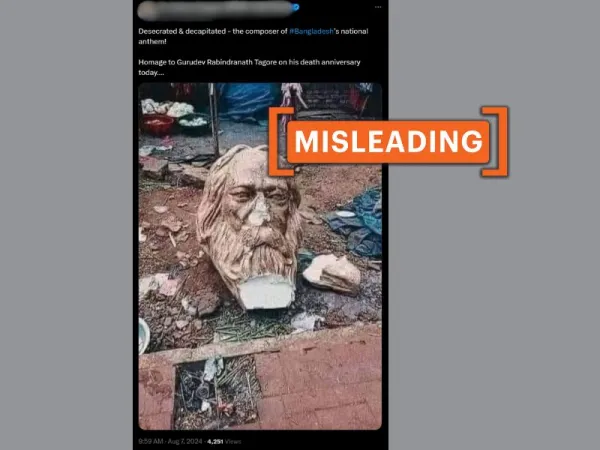By: Tahil Ali
August 7 2024
 Screenshot of a social media post shared with the claim that this statue of Rabindranath Tagore was vandalized during the ongoing Bangladesh unrest. (Source: X/Modified by Logically Facts)
Screenshot of a social media post shared with the claim that this statue of Rabindranath Tagore was vandalized during the ongoing Bangladesh unrest. (Source: X/Modified by Logically Facts)
The photo, from 2023, shows a statue of Rabindranath Tagore that was vandalized at Dhaka University. It is unrelated to recent violence in Bangladesh.
What is the claim?
A photo of a broken statue head purportedly depicting the renowned Indian poet and Nobel laureate Rabindranath Tagore is circulating on social media. The claim is that the statue was vandalized on Tagore's death anniversary in Bangladesh amid the ongoing unrest in the country, which began with protests over a quota reservation system and escalated into violence leading to the resignation of Awami League leader Sheikh Hasina as Prime Minister of Bangladesh.
On X (formerly Twitter), one user shared the photo (archived here) with the caption: “Desecrated & decapitated - the composer of #Bangladesh’s national anthem! Homage to Gurudev Rabindranath Tagore on his death anniversary today….”
Another X user, in reference to the unrest, posted the photo with the caption: “Vandalism continues in Bangladesh as radicals target the bust of Nobel Laureate Rabindranath Tagore, who also wrote the national anthem of both Bangladesh and India.” Archived versions of these posts are available here and here.
Screenshots of the viral posts on social media. (Source: X/Modified by Logically Facts)
However, our investigation revealed that the photo is from an incident at Dhaka University in 2023 and is not connected to the current unrest in Bangladesh.
What are the facts?
A reverse image search reveals that the photo is from an incident at Dhaka University in 2023 and is not related to the current unrest in Bangladesh.
According to a February 17, 2023, news report by Dhaka-based Bengali news outlet Prothom Alo, students from the sculpture department of the Faculty of Fine Arts at Dhaka University installed a 19-and-a-half-foot sculpture of Tagore near the Raju Memorial Sculpture as part of a public art exhibition.
Two days after its installation, the statue went missing. The broken head and other fragments were eventually found in Dhaka’s Suhrawardy Gardens.
The Tagore statue depicted him with tape over his mouth, holding "Gitanjali," his Nobel Prize-winning collection of poems, with a nail pierced through it. Made of bamboo, thermocol, and paper, the statue was erected to protest censorship and the suppression of free thought, creativity, and expression in the country. A video published by Prothom Alo (archived here) on February 16, 2023, documented both the installation and the aftermath of the statue's disappearance.
According to Hindustan Times Bangla, students protested after the Tagore statue was removed, claiming that Dhaka University authorities had taken it down without informing them. Initially, the university denied the allegation but later admitted to removing the statue, asserting that it had been installed without permission.
Screenshot from a news report about this incident. (Source: Prothom Alo/Bangla Hindustan Times/Modified by Logically Facts)
Professor Dr. AKM Golam Rabbani, then Dhaka University's proctor, stated that the unauthorized placement of the sculpture had compromised the aesthetic appeal of the Raju Memorial Sculpture. As reported by Dhaka Tribune, Rabbani said, “The institution has a policy on placing sculptures on the university premises. The sculpture was placed without informing the university administration. Therefore, the university administration removed it.”
A few days later, a new version of the statue was erected at the same location, constructed from the fragments of the original statue found around the campus, according to a February 18, 2023, report by Dhaka Tribune.
What is happening in Bangladesh?
Since June, students in Bangladesh have protested a quota system for government jobs that reserved 30 percent of positions for descendants of the freedom fighters from the 1971 independence war. Although the Hasina-led government initially abolished the policy, it was reinstated by a High Court, leading to widespread protests. The Supreme Court later partially overturned the lower court's decision, but protests evolved into broader agitation against Hasina and the Awami League-led government.
According to a France 24 report, the protests have resulted in at least 300 deaths and numerous injuries. On August 4, nearly 100 people were killed, prompting calls for Prime Minister Hasina's resignation. Hasina resigned and left the country on August 5.
Following her departure, protesters breached the prime ministerial palace in Dhaka and vandalized a statue of Sheikh Mujibur Rahman, the nation's founding father and former president, in the Bijoy Sarani area.
Meanwhile, Bangladesh Army Chief General Waker-Uz-Zaman announced the formation of an interim government, with reports indicating that Nobel Peace Prize laureate Muhammad Yunus would serve as chief adviser.
The verdict